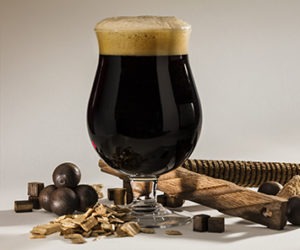Temperature Management Science
Brewers long ago realized the important role temperature plays in brewing beer, and have taken steps to measure and control it. Long before the first thermometer was available, early brewers were able to determine the readiness of the brewing liquor by observing their reflection on the surface of the heating liquid. When they could no longer see their face the water was hot enough.
Decoction mashing: early temperature control in mashing
The standard story is that the earliest decoction mashing systems arose out of the need for precise temperature control in the absence of instruments. Mashing at ambient temperature then removing 1/3 of the mash and boiling it before adding it back, and repeating this three times takes the mash through a series of rests that correspond roughly to the temperature optima for the various barley enzymes.
Seasonal brewing: early temperature control in fermentation
In Europe brewing had a season, as warm summer temperatures made the fermentation of lager styles impossible. In the late spring, beers were placed in underground caves packed with ice cut from lakes to keep them fresh throughout the long hot summer. The early history of the United States witnessed many pioneer businessmen who thought it a good idea to ship ice from cold to warm climates. Obviously losses were a huge issue, but many designed and built effective insulated containers.
The rise of refrigeration
In 1842, the American physician John Gorrie, responding to a need to cool sickrooms in a Florida hospital, designed and built an air-cooling apparatus for treating yellow-fever patients. His basic principle which involved compressing a gas, cooling it by sending it through radiating coils, and then expanding it to lower the temperature further, is the one most often used in refrigerators today. Giving up his medical practice to engage in time-consuming experimentation with ice making, he was granted the first U.S. patent for mechanical refrigeration in 1851.
Commercial refrigeration is believed to have been initiated by an American businessperson, Alexander C. Twinning, in 1856 Shortly afterward, an Australian, James Harrison, examined the refrigerators used by Twinning and introduced vapor-compression refrigeration to the brewing and meatpacking industries. Brewing was the first activity in the northern states to use mechanical refrigeration extensively, beginning with an absorption machine used by S. Liebmann’s Sons Brewing Company in Brooklyn, New York in 1870. Commercial refrigeration was primarily directed at breweries in the 1870s and by 1891, nearly every brewery was equipped with refrigerating machines. This prompted the spread of lager style beers across the United States as the frontier moved West. In San Francisco an anomaly developed. Popularity of lager style beer outstripped the availability of commercial refrigeration, but the naturally cool climate of the northern California coast led to the development of Steam beers, which are lagers brewed at ale temperatures.
In modern breweries, heating and cooling mechanisms are tightly controlled by various controllers. A first step towards controlling temperature is finding a way to measure it.
What is temperature?
Temperature is technically a property that determines the direction thermal energy will be transferred when an object contacts another object. Thermal energy spontaneously moves from objects of higher temperature to objects of lower temperature. Defining temperature this way is necessary for chemists and physicists. However, as brewers we can use a more colloquial definition of temperature as a measure of how hot something is. A thermometer is, of course, a device which measures temperature.
Measurement of temperature
The measurement of temperature is relatively cheap and easy these days with the wide availability of thermometers. It is wise to understand the limitations of some of the more commonly available thermometers. However, for homebrewers wishing to have better control over their process, the first decision a home brewer should make is what units to use when measuring temperature.
Various temperature scales
Centigrade
Sometimes known as Celsius (after Anders Celsius), this is a metric system that assigns a value of zero to the freezing point of pure water and a value of 100 to the boiling point at sea level of pure water. Each unit between 0 and 100 is called a degree.
Fahrenheit
Still used in the U.S. to measure temperature. It assigns values for the boiling point of pure water at sea level at 212º and the freezing point at 32º. Degrees in Fahrenheit are “smaller” as there are 180 degrees between freezing and boiling, compared to 100 in the case of Centigrade.
Kelvin
Used in calculations when considering the properties of a physical or engineering system. Absolute zero, the theoretical minimum is 0 K. Freezing point of pure water is 273 K and each individual Kelvin degree is the same as a centigrade degree, TK = T°C + 273. (In the Kelvin scale, the symbol for degree (°) is not used and the unit itself (kelvin) is not capitalized.)Raumer In central Europe and therefore in some traditional European and North American breweries this scale is still used. Water freezes at 0 degrees and boils at 80 degrees.
Types of thermometers
1. Liquid expansion, in which a liquid (often mercury), iodine, alcohol expands or contracts inside a graduated cylinder
2. Electrical, in which a change in electrical resistance in a small coil of wire is measured. Includes thermocouples, in which the current flowing between two different metals changes relative to the temperature.
3. Metallic expansion, in which differential expansion of two metals causes a metal strip to bend (as in a dial thermometer).
All three types are commonly used in commercial and in home breweries.The liquid in glass is perhaps the most familiar as it is the type most often used around the house. In a commercial brewery and in your home brewery, the accuracy of the mercury in glass thermometer is valuable, but the risk associated with using it directly to measure the brew temperature makes it an unwise choice. These thermometers are fragile and can easily break, so if you are using it to measure the temperature of your mash, your sparge water, your kettle or your fermentation then you risk contaminating the batch with mercury should an accident occur. Of course should this occur the batch should be thrown away immediately and the mercury contained and safely disposed of if possible.
Thermometers must come to thermal equilibrium with the solution they measure before they read accurately. With a mercury thermometer, this may take 15–20 seconds. Electronic thermometers with slim probes {“thermopens”) are somewhat expensive, but allow for quick temperature measurements, some within three seconds.
Calibration
I advocate having a mercury in glass thermometer, and using it to check the accuracy or calibrate the more robust workaday thermometers used in the actual brew. Simply heat some water to the desired temperature range and put both thermometers at a point close to each other in the liquid. Either adjust the bimetal or resistance thermometer until it reads the same as the mercury in glass thermometer, or note the difference and remember to add or subtract it from the reading when using the less accurate thermometer. A glass thermometer that contains a liquid other than mercury may be more useful and slightly safer, but broken glass is still dangerous.
Thermocouples are found in commercial breweries situated in metal housings or “thermowells” in the walls of tanks or pipes. Brewers use them to measure the temperature of the liquid inside the tank or pipework and often link their electrical output to a controller of some kind that can open or close a valve or solenoid. This may allow a heating medium such as steam, or a cooling medium such as iced water or propylene glycol (food grade anti-freeze) to flow through jackets on the tank to heat or cool the liquid inside. More sophisticated home brewing systems may incorporate such devices into the design.
The mash
In previous articles we have discussed at length how temperature will affect the various chemical and biochemical (enzyme) reactions in the brew. The mash temperature is an important part of determining the beer’s characteristics as each enzyme responsible for the degradation of the malted barley endosperm material has different optimal temperatures and varying the mash temperature will favor the action of one enzyme over another. For example, in a single temperature infusion mash increasing the mash temperature from 149 to 156 °F (65–69 °C) increased the beer’s terminal gravity from 1.008 to 1.014 changing the sensory properties of the beer. The thermometer used to measure the mash temperature should be accurate to at least 1 °F. No use in using the meat thermometer for that task. Also, the temperature in a mash should be checked at more than one spot to ensure that mash temperature is uniform. This is especially important in cases where the mash is not stirred.
The boil
Wort boiling is of slightly less importance when it comes to measuring temperature in that you can see whether it’s boiling or it’s not. Since wort is a weak sugar solution — or not so weak in the case of some home brews I’ve tasted — it actually boils a few degrees above the boiling point of water. Of course if you’re brewing at altitude elevation, say in Denver, then the boiling point of wort is lower than it is at sea level. The reactions that lead to protein and tannin coagulation are temperature dependent, as are the reactions that lead to DMS volatilization, so it is wise to boil your wort slightly longer. (For example, 2 hours rather than 90 minutes).
Wort cooling
The wort must be cooled to the appropriate temperature for fermentation and maintained there despite the yeast’s best efforts to increase the temperature of its surroundings by giving off heat during growth and active fermentation. Again accuracy in measuring the fermentation temperature is key so a thermometer that can measure accurately within 1 °F is a good investment.
Once wort is cooled to around 140 °F (60 °C), it is susceptible to wort-spoiling bacteria. When measuring cooling wort, be sure to use a clean, sanitized thermometer to avoid
contaminating it.
Fermentation
It is possible to purchase good quality temperature regulators that can be used in a commercial fridge or freezer to create a consistent temperature fermentation. The one I use has a dial to set the desired temperature, and a bimetal thermometer that goes in the fridge. The fridge plugs into it and the controller plugs into the wall. The fridge simply turns on and off to adjust the temperature as needed.
Less sophisticated methods include using the physics of evaporation to cool fermentation carboys or barrels. Simply wrapping the container in a wet towel and blowing air over it with a fan provides a degree or two of cooling. Fermentation temperature is vital for consistency, which is why commercial brewers really need to focus on temperature control. Wort is collected at the same temperature every time and carefully controlled during primary fermentation. A small increase in temperature can lead to a large increase in some of the metabolic pathways yeast use, for instance one experiment shows increasing fermentation temperature of a lager beer from 46 to 54 °F (8 to 12 °C) almost tripled the ester content of the beer. (Esters are responsible for fruity flavors.) When beer is subsequently aged the ageing temperature is important in determining the beer’s flavor and clarity.
If you use a temperature-controlled fermentation — such as a chest freezer or heated box — be aware that the temperature of your beer may be different than the temperature of the chamber. This is especially true early in fermentation or with high-gravity fermentations. Temperature-sensitive strips affixed to carboys aren’t very accurate, but they can alert you if the heat of the fermentation is causing wort temperature to greatly exceed ambient temperature in the chamber.



